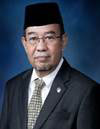
Dear Colleagues,
Happy New Year 2017! We wish you every success in your paths ahead. The year 2016 has been a great year for INTOSAI WGEA as the 2014-2016 Work Plan was successfully accomplished and the 2017- 2019 Work Plan was effectively put together. These important decisions were undertaken during the 17th WGEA Assembly in October 2016 in Jakarta, Indonesia. I would like to sincerely thank all 115 delegates from 48 SAIs, 4 United Nations organisations, and academic institutions who participated in the meeting.
The meeting was also a forum to exchange knowledge and experiences in the field of environmental auditing and on the latest issues such as Sustainable Development Goals (SDGs) and …
Read More...In this edition of greenlines, we have two feature stories on:
In addition to that, there is also a Feature Extra on INTOSAI WGEA Guidance, Research Papers and ISSAIs, 2014-2016: Sharing Knowledge and Best Practices.
Gr…
Read More...
Read about your fellow auditors' work on environmental issues

Dear Colleagues,
Happy New Year 2017! We wish you every success in your paths ahead. The year 2016 has been a great year for INTOSAI WGEA as the 2014-2016 Work Plan was successfully accomplished and the 2017- 2019 Work Plan was effectively put together. These important decisions were undertaken during the 17th WGEA Assembly in October 2016 in Jakarta, Indonesia. I would like to sincerely thank all 115 delegates from 48 SAIs, 4 United Nations organisations, and academic institutions who participated in the meeting.
The meeting was also a forum to exchange knowledge and experiences in the field of environmental auditing and on the latest issues such as Sustainable Development Goals (SDGs) and Multilateral Environmental Agreements (MEAs). During the XXII INCOSAI in December in Abu Dhabi, as Chair of INTOSAI WGEA, I had the privilege to present the outputs of the 2014-2016 WGEA Work Plan. In relation to this, I would like to inform you that the INTOSAI Governing Board has endorsed the WGEA updates of International Standards of Supreme Audit Institutions (ISSAI) 5110, 5120, and 5140. At this time, allow me to express my sincerest appreciation to all of the WGEA members, Steering Committee members, and regional coordinators for their active support and contributions. Without their efforts, these outstanding outputs would not have been achieved.
The 2017-2019 Work Plan will explore important environmental issues covering SDGs, MEAs, climate change, and other topics. The projects that will be undertaken include the creation of research papers and audit guidance on environmental topics, development of training tools based on previous research tools, and the updating of guidance material on auditing biodiversity in collaboration with the Convention on Biological Diversity (CBD).
In addition, capacity-building activities such as training will be provided on environmental auditing in the WGEA Global Training Facility in India and on forestry auditing by the SAI of Indonesia.
With a new mix of members undertaking these projects and with many new and innovative topics to cover, I am certain that we will have an interesting 3 years ahead of us. I hope that the successful achievements of the 2014-2016 Work Plan will be a motivation for all of us to accomplish the 2017-2019 Work Plan.
Finally, I would like to thank you all for your active commitment and support for the INTOSAI WGEA activities. I hope that your support and active participation will continue during the 2017-2019 Work Plan and onwards.
Chairman
Audit Board of the Republic of Indonesia
Harry Azhar Azis, PhD.
In this edition of greenlines, we have two feature stories on:
In addition to that, there is also a Feature Extra on INTOSAI WGEA Guidance, Research Papers and ISSAIs, 2014-2016: Sharing Knowledge and Best Practices.
Greening Supreme Audit Institutions
Climate change and environment degradation are fundamental threats to sustainable economic development and the fight against poverty. Effective management of the environment requires both micro-level and macro-level approaches that involve all stakeholders – governments, intergovernmental and business organizations, the scientific community, the private sector, NGOs, and others. All stakeholders need to work together to address economic, social, and environmental challenges in the interest of a more sustainable future for the planet and human beings. The goals of an environmentally responsible entity include the following:
 Greening Supreme Audit Institutions
Greening Supreme Audit Institutions
Whether in our homes or in our offices, we need to act in an environmentally responsible manner and be resource efficient. About 40% of raw material and resources are consumed in offices. Therefore, it can be a good initiative for Supreme Audit Institutions (SAIs) to take steps to green their offices. To reduce offices’ impacts on the environment, they should adopt green practices; by doing so, SAIs can lead by example and strive to be model organizations.
As environment auditors, SAIs not only need to demonstrate their commitment to sustainability issues and to the environment, but they also need to be more environment-friendly than their audited entities before judging them through audits.
In the context of SAIs, Greening means encouraging initiatives, activities, and processes to reduce resource use, pollution, and the SAI’s carbon footprint. SAI India led a research project about Greening SAIs in the INTOSAI WGEA Work Plan 2014-2016. The project’s objectives were to explore methods and sustainable environment practices adopted by the SAIs of the world and to serve as a platform to share experiences. This project paper could serve as a blueprint for action by SAIs; it contains tools available to and applied by various SAIs around the world as well as identifies challenges and strategies for achieving Greening objectives.
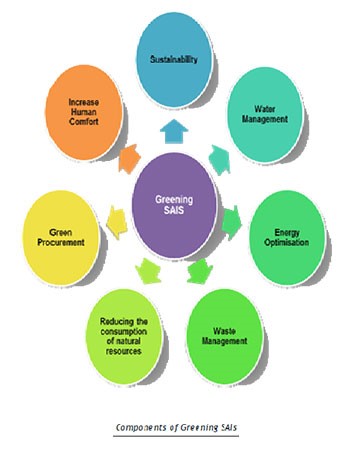
Tools for Greening SAIs
Greening SAIs is reflected in a change in behavioral management toward more environmentally sustainable work. It is
important to develop management policies through which a ‘green’ attitude translates into ‘green’ behavior and such behavior becomes a social norm. The tools to achieve Greening in SAIs can be classified as:
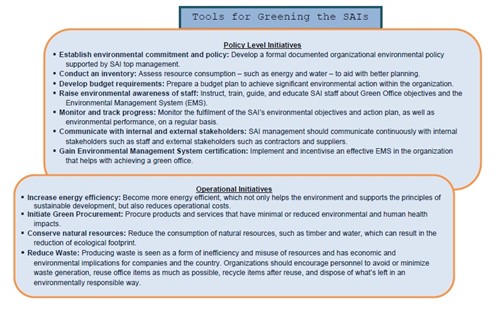
Strategies and Challenges
37 SAIs have shared the green practices they followed during the “Greening the SAIs” research project. Almost all of the SAIs recorded their efforts to conserve resources by saving paper, going digital, managing waste efficiently, using ecofriendly transportation, and greening procurement, among other activities. Many SAIs are focusing on saving water and energy through innovations based on strategy, use of technology, and creating awareness among stakeholders, among others. A few significant green practices some SAIs followed are tabulated below.
SAIs willing to go green may face challenges such as resource constraints, lack of national regulations, lack of acceptance by staff, lack of expertise, and challenges in maintaining green initiatives. To mitigate these challenges, SAIs can adopt various strategies such as taking small steps that are not resource intensive, earmarking funds for maintenance, incentivizing active participation of staff, and encouraging voluntary participation of experts.
iCED: SAI India’s showcase of Green Practices
SAI India established the International Centre for Environmental Audit and Sustainable Development (iCED) in 2010. From 2011 to 2013, iCED became the Global Training Facility (GTF) of INTOSAI WGEA in the field of environment auditing and sustainable development. SAI India through this project has attempted to showcase environment-friendly features:


Energy Management and Conservation: The building is constructed to maximize energy conservation by using features such as skylights, heat insulation, overhangs and fins, double-glazed windows, and building orientation optimization. Installations such as lift and cooling systems and all electrical fittings are energy efficient. Solar energy is tapped through Solar PV Panels to generate electricity and heat water.


Water conservation: Water is recycled and used for gardening through sprinklers and drip systems. Bathroom fittings ensure water use efficiency. Rain water is harvested to store 600,000 liters.


Waste Management: Waste management practices such as waste segregation and e-waste management are implemented. There is a stated policy of minimizing use of paper, paper cups, etc. iCED discourages the use of plastic on its campus, and it used Fly Ash Bricks during construction.
Geothermal cooling: Geothermal cooling is used in part of the building instead of conventional cooling. The cooling system in the rest of the building is also based on a water chilling technique.
17th INTOSAI WGEA Assembly Meeting
The Audit Board of the Republic of Indonesia (BPK) had the honor of hosting the 17th Assembly Meeting of INTOSAI WGEA. From October 24-27, 2016, 115 delegates from 48 Supreme Audit Institutions (SAI),4 United Nations (UN) organizations, and academic institutions gathered together in Jakarta, Indonesia, to exchange knowledge about and experiences with auditing current environmental issues, such as Sustainable Development Goals (SDGs), Multilateral Environmental Agreements (MEAs), and Cooperative Audits. This meeting also endorsed the output of the INTOSAI WGEA 2014-2016 Work Plan and discussed and approved the INTOSAI WGEA 2017-2019 Work Plan.
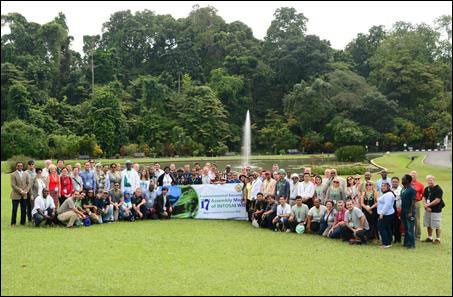
The delegates took a picture on the environmental excursion in Bogor Botanical Garden.
The meeting kicked off with an environmental excursion on the first day to Bogor Botanical Garden, located on the outskirts of Jakarta, where the delegates saw the various biodiversity on display. In the evening, a cocktail gathering was held to welcome the delegates to the meeting and allow them to get to know each other.
On the second day, the meeting started with an opening ceremony, during which the President of the Republic of Indonesia officially opened the Assembly meeting.
The first session on the topic of “Sustainable Development Goals and Environmental Sustainability” had three keynote speakers. First, a speaker from the Ministry of National Development Planning of Indonesia delivered a government’s perspective on this issue. Second, a speaker from the United Nations Department of Economic and Social Affairs (UNDESA) shared the department’s view on this topic. The final speaker, Dr. Harry Azhar Azis, Chairman of SAI Indonesia, disseminated his paper entitled “The Role of SAIs in Achieving SDGs.”
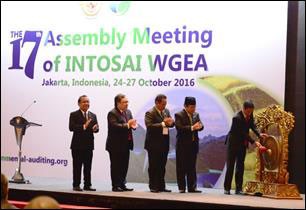
The President of the Republic of Indonesia, Mr. Joko Widodo, at the opening ceremony.
The second session of the day was a plenary on the topic of “Multilateral Environmental Agreements (MEAs): Current Issues and Progress.” Moderated by Julie Gelfand, Commissioner of the Environment and Sustainable Development of SAI Canada, the plenary session had four panelists from UNEP, UNFCCC, CBD, and the Ministry of Environment and Forestry of Indonesia. The final session of the day was on INTOSAI WGEA matters. In this session, the Chairman of SAI Indonesia, as Chair of INTOSAI WGEA, along with the head of the INTOSAI WGEA Secretariat, reported on the progress of INTOSAI WGEA, the results of the 8th Survey on Environmental Auditing, approval of the 2014-2016 Work Plan, and the introduction of the 2017-2019 Work Plan.
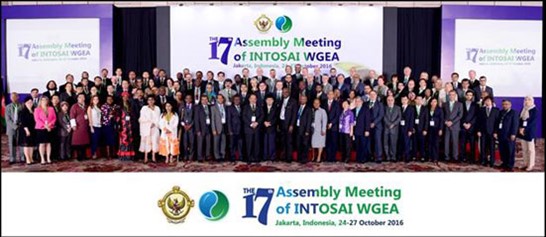
The third day began with a plenary session on “Sustainable Development Goals: Stakeholders’ Perspectives and Roles.” Moderated by Dr. Alar Karis, Auditor General of Estonia, panelists for this session came from different backgrounds, such as academics from SDGs Center Padjajaran University and Australian National University. In addition, SAI UAE, as Chair of INTOSAI, shared INTOSAI’s view on SDGs, and SAI Canada shared its experience in auditing government’s preparedness to implement SDGs.
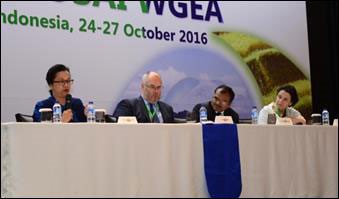
Speakers at the plenary session on “Sustainable Development Goals: Stakeholders’ Perspectives and Roles”
After the plenary session, eight parallel sessions were held on the 2014-2016 Work Plan outputs. The parallel sessions presented the results and country papers for the seven research projects and the guidance update in smaller groups so that participants could actively engage and discuss each topic. After the parallel sessions concluded, all of the participants gathered together to share the outcome of the discussions from the sessions. To end the third day, a gala dinner was held in the evening as a token of appreciation to all of the delegates who came from all over the world to attend the Assembly Meeting.
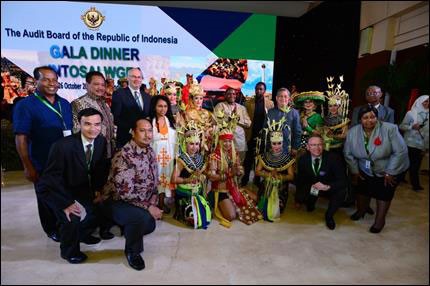
The final day of the meeting started with presentations of Regional WGEA Progress Reports. Representatives from each of the regional working groups—ACAG/PASAI WGEA, EUROSAI WGEA, AFROSAI WGEA, ASOSAI WGEA, COMTEMA (OLACEFS), and ARABOSAI WGEA—presented their activities. Next, Mr. Jonathan Keate, SAI New Zealand, moderated the session on “Cooperative Audits and SDGs.” Presenters from SAI Brazil, SAI Canada, SAI Russia, SAI Poland, SAI South Africa and SAI Ukraine shared their experiences on cooperative audits and SDGs. Afterwards, during a session on WGEA Trainings and Greenlines, presenters reported on the various trainings conducted by INTOSAI WGEA, such as GTF in India and International Training on Forestry in Indonesia, and the Greenlines Newsletter. Also in this session was a presentation on the cooperation with INTOSAI Development Initiatives (IDI) and the INTOSAI Working Group on Extractive Industries (WGEI). To end the meeting, the Chairman of SAI Indonesia, as Chair of INTOSAI WGEA, delivered concluding remarks. Some key outcomes from the meeting are:
After delivering the conclusion of the meeting, the Chairman of SAI Indonesia, as Chair of INTOSAI WGEA, officially closed the 17th INTOSAI WGEA Assembly Meeting.
FEATURE EXTRA :
INTOSAI WGEA Guidance, Research Papers and ISSAIs 2014-2016: Sharing Knowledge and Best Practices
During the 2014-2016 Work Plan, INTOSAI Working Group on Environmental Auditing (WGEA) completed seven research papers, one updated guidance on waste management, and reviews of four International Standards of Supreme Audit Institutions (ISSAI) series 5000 on environmental auditing. ISSAI 5110, 5120, and 5140 have been endorsed by the INTOSAI Governing Board, while ISSAI 5130 was postponed. These documents were approved by WGEA members during its 17th Assembly Meeting in Jakarta, Indonesia, and were reported to the INTOSAI Governing Board and XXII INCOSAI in Abu Dhabi.
A summary of WGEA’s output for 2014-2016 is presented below.
Energy Savings

The International Energy Agency (IEA) regards energy efficiency as the most important source of energy. A considerable part of IEA’s World Energy Outlook (WEO) 2013 was devoted to this subject. This is evidence of the heightened attention that has been paid to energy efficiency recently.
The main objective of this study is to elaborate further the theoretical parts of the Auditing Sustainable Energy handbook, specifically those parts devoted to energy consumption, energy savings, and energy efficiency, including countries’ energy policy tools.
The study’s principal goals are to highlight the importance of energy savings as a potential area for audit by SAIs and to elaborate on this topic by providing examples and case studies and Supreme Audit Institutions’ (SAI) best practices in this field.
This study is divided into three parts:
1. Background information on the issue of energy savings;
2. Political and legal frameworks in the area of energy savings; and
3. Auditing energy savings issues (INTOSAI community experience).
This research paper project was led by SAI Czech Republic, with subcommittee members from SAI China, SAI Egypt, SAI Estonia, SAI Ethiopia, SAI Morocco, SAI Netherlands, SAI Norway, SAI Philippines, SAI Slovakia, SAI Swaziland, SAI United States, SAI United Kingdom, and SAI Zambia.
Greening SAIs
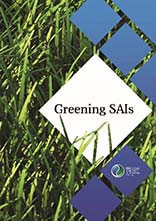
As environment auditors, SAIs need to demonstrate their commitment towards the environment by initiating efforts to be greener. By adopting green practices, SAIs can set an example and strive to be model organizations; this would also enhance SAIs’ credibility in the eyes of their citizens.
The main objective of this research project is to explore methods and practices for Greening SAIs worldwide. The paper seeks to set out steps SAIs can follow with regard to sustainable environment practices to achieve Greening. It is expected to help SAIs that want to take concrete steps in Greening, and it recognizes the challenges and barriers in the Greening process. This project can also serve as a platform for various SAIs worldwide to share the practices they have adopted to enhance Greening features. As environment auditors, we also need to demonstrate our commitment to protecting the environment; therefore, this paper can also serve as a blueprint for action by SAIs in this area.
This research paper project was led by SAI India, with subcommittee members from SAI Burkina Faso, SAI Chad, SAI Namibia, SAI Poland, SAI Senegal, and SAI Swaziland.
Market-based Instruments for Environmental Protection and Management

Governments need to choose policy instruments to implement their environmental policies and to achieve environmental goals. For that purpose, they may use traditional command-and-control approaches, but they may also choose to use market-based instruments as a more efficient or more acceptable approach to meeting their objectives. In practice, it is not about making a choice between regulatory and market-based instruments, but rather about finding a good mix between these two approaches.
This paper gives a brief overview of market-based environmental policy instruments (MBIs) – what they are, why governments use them, and how they can help governments achieve environmental objectives. The paper also discusses SAIs’ potential role in auditing MBIs and presents the experience of various SAIs to date, providing an overview of opportunities and common risks and obstacles that auditors might need to consider in auditing MBIs.
This research paper project was led by SAI Estonia, with subcommittee members from SAI Bhutan, SAI Brazil, SAI Cameroon, SAI Indonesia, SAI New Zealand, SAI Netherlands, SAI Senegal, and SAI United Kingdom.
Environmental Impact Assessment
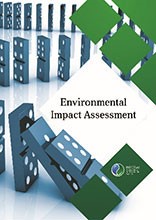
The Seventh Survey on Environmental Auditing of the INTOSAI WGEA underlined environmental assessment (EA) as one of the key issues to be addressed by the WGEA. Conducting EAs is mandatory in national legislation and directives in most countries. EAs are also part of the commitments for international environmental treaties, such as the Convention on Biological Diversity, and are required by international institutions such as the World Bank.
This research project’s objective is to provide SAIs with a general understanding of what an EA is, how to conduct an EA, what the challenges are in implementing an EA, and why EAs are important to the auditing community. The research provides numerous sources and experts worldwide that SAIs can consult for more information. Finally, the project provides SAIs with some examples of sources of criteria for auditing EAs that are drawn from other national audit offices. Sources of criteria include:
This research paper project was led by SAI Canada and India, with subcommittee members from SAI Brazil, SAI Ethiopia, SAI Ghana, SAI Iran, SAI Norway, SAI Tanzania, and SAI Uganda.
Auditing Government Efforts to Adapt to Climate Change
and Ocean Acidification in the Marine Environment
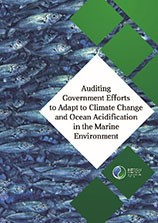
According to projections from the Intergovernmental Panel on Climate Change (IPCC), the future marine environment may look considerably different from the present marine environment as a result of climate change and ocean acidification. In particular, the IPCC has reported that changes in ocean conditions due to climate change and ocean acidification—such as warmer temperatures, increasing acidity, and rising sea levels—could affect marine ecosystems in potentially significant but not fully understood ways. Any changes that occur in marine ecosystems could subsequently have a profound impact on people, because marine ecosystems support important habitats and species that generate food, jobs, and economic activity, and large numbers of people worldwide live in coastal areas.
This report addresses the role of SAIs in supporting government efforts to respond to these issues in the marine environment. Specifically, this report describes (1) the potential effects of climate change and ocean acidification on the marine environment and examples of government efforts to adapt to these effects; (2) previous SAI audit work related to climate change and ocean acidification issues in the marine environment; and (3) the challenges SAIs have experienced in auditing these issues and approaches SAIs can take to help overcome these challenges.
This research paper project was led by SAI United States, with subcommittee members from SAI Bulgaria, SAI Indonesia, SAI Kenya, SAI Kuwait, SAI Morocco, SAI Netherlands, SAI Norway, SAI Philippines, SAI Senegal, and SAI Yemen.
Renewable Energy
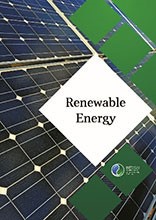
Many countries face some obstacles to developing their renewable energy sector. The major obstacles are inherent to the institutional frameworks, the absence of effective policies to boost renewable energy technologies, and financing difficulties. These challenges highlight the need for SAIs to focus on this area. Thus, it is important for SAIs to implement an effective framework for auditing renewable energy to help governments and other stakeholders promote the development of this sector.
This research project intends to help SAIs review their governments’ energy policies by providing comprehensive data on renewable energy. It also aims to give information regarding renewable energy audit topics with examples and case studies of best practices in this field. The analysis focuses on a brief review of practices for auditing renewable energy and on the identification of recurring topics related to auditing renewable energy.
This research paper project was led by SAI Indonesia and Morocco, with subcommittee members from SAI China, SAI Czech Republic, SAI Ethiopia, SAI Iraq, SAI Lesotho, SAI Macedonia, SAI Namibia, SAI Philippines, SAI United Kingdom, SAI United States, and SAI Zambia.
How To Increase The Quality and Impact of Environmental Audits
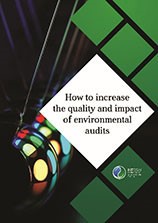
As SAIs now regularly conduct environmental audits, they face the challenge of bringing about change. Such impact can be achieved when quality is attached to auditing. Therefore, as with other types of audits, increasing the quality and impact of environmental audits is becoming a major concern for SAIs.
This research project presents tips and information on how SAIs worldwide can overcome challenges related to conducting high-quality environmental audits that can also have significant impacts. This paper provides information on how SAIs tackle issues pertaining to their quest for quality and performance in the entire audit process; this information is developed in chapters on the planning, audit execution, reporting, and audit follow-up phases.
This research paper project was led by SAI Lesotho and Cameroon, with subcommittee members from SAI Botswana, SAI Estonia, SAI Ethiopia, SAI Indonesia, SAI Norway, SAI Tanzania, SAI Thailand, and SAI Uganda.
Updated Guidance on Auditing Waste Management
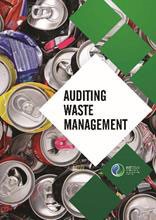
Waste is a continually growing global, regional, and local problem. If waste is not properly handled, it can cause global, regional, and local pollution. Unsound management of waste may lead to the contamination of soil and freshwater, as well as air emissions and marine pollution. These may in turn entail serious risks for the environment and for human health.
This is an updated version of the INTOSAI guidance Towards Auditing Waste Management (2004).
This guidance explains the background orientation of waste, methodology on waste audits, and steps on auditing waste management, such as identifying environmental and health risk scenarios for waste management, mapping out the actors and their responsibilities, identifying possible governance problems related to waste management, and selecting an audit topic.
This research paper project was led by SAI Norway.
Reviewed ISSAI 5100 series on Environmental Auditing
We are pleased to inform you that the ISSAI 5110 – Guidance on Conducting Performance Audit with an Environmental Perspective; ISSAI 5120 – Environmental Auditing in the Context of Financial and Compliance Audits; and ISSAI 5140 – How SAIs May Co-operate on the Audit of International Accords, were endorsed during the XXII INCOSAI in Abu Dhabi. We would like to congratulate all SAIs involved in the ISSAI review process and all WGEA members for this important achievement.
Meanwhile, the endorsement of ISSAI 5130 – Sustainable Development: The Role of Supreme Audit Institutions has been delayed while we await the result of a decision made at XXII INCOSAI, where the Secretariat of WGEA and SAI Canada, along with the Secretariat of INTOSAI and SAI UAE, discussed how to proceed with ISSAI 5130. They decided to form a group of experts to manage the issue on Sustainable Development Goals; INTOSAI WGEA will be part of this group.
The SAIs of Indonesia and Brazil led the review of the ISSAI 5100 series on environmental auditing.
ISSAI 5110 – Guidance on Conducting Performance Audit with an Environmental Perspective

The document reflects the experiences of SAIs and serves as a tool to help auditors conduct audits with an environmental focus and to provide good practices.
The first section of this ISSAI introduces essential elements in planning an environmental audit. The second section describes the most commonly identified subjects of environmental audits, in particular the performance of environmental programmes and their potential environmental impact, environmental management systems and their reporting procedures, and possible evaluations of proposed environmental policies and programs. The third section sets out specific elements in designing environmental audits, such as audit questions, methods and techniques, audit criteria, and data collection.
The review of ISSAI 5110 – Guidance on Conducting Performance Audit with an Environmental Perspective was co-led by the European Court of Auditors (ECA).
ISSAI 5120 – Environmental Auditing in the Context of Financial and Compliance Audits
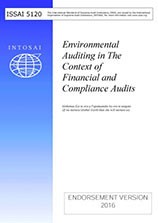
This guideline is based on the generally accepted principles of financial and compliance auditing introduced in ISSAI 200 and ISSAI 400 and on current good practices in environmental auditing. It covers environmental issues in the context of financial and compliance audits and has been written to meet the needs of this entire area.
The first section of this ISSAI introduces the nature of environmental auditing, setting out the character of financial, compliance, performance, and sustainable development auditing. The second section describes in detail the purpose, objectives, and various approaches to financial and compliance auditing. The third section sets out specific methods and techniques the auditor can use to obtain knowledge of environmental matters and assess inherent risks, how laws and regulations are considered, how audit criteria are defined, and how to perform substantive auditing procedures. Finally, the fourth section provides information on governmental reporting on environmental and sustainability issues.
The review of ISSAI 5120 – Environmental Auditing in The Context of Financial and Compliance Audits was co-led by the European Court of Auditors (ECA).
ISSAI 5140 – How SAIs May Cooperate on the Audit of International Environmental Accords
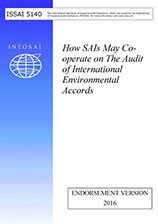
In the last few decades, governments have entered into international and trans-regional agreements and successfully negotiated on global environmental issues including climate change, biodiversity and desertification, hazardous waste and chemicals, and renewable energy and energy saving. The transboundary nature of environmental issues and government environmental policy implies that cooperation among SAIs is desirable.
The primary objectives of this guide are to (1) define the different types and natures of cooperative audits, (2) identify the advantages and disadvantages of each type of cooperative audit, (3) identify the approaches by which SAIs can cooperate in conducting audits of international environmental accords, and (4) describe a protocol or agreement for SAIs to use when performing the audits (planning, field work, and reporting).
The review of ISSAI 5140 – How SAIs May Cooperate on The Audit of International Environmental Accords was co-led by SAI Philippines.
INTOSAI WGEA held the 17th Assembly meeting October 24-27, 2016, in Jakarta, Indonesia. The meeting was attended by 115 delegates from 48 SAIs, 4 UN Organizations, and academics. In general, the meeting discussed and approved:
INTOSAI WGEA, in cooperation with the SAI of India, organized the 4th Global Training Facility Course on Environmental Auditing from November 21 to December 5, 2016, at the International Center for Environment Audit and Sustainable Development in Jaipur, India. This training introduced the concept of environmental auditing of biodiversity, water, waste, and climate change. The faculty came from various SAIs, including Estonia, the European Court of Auditors, Indonesia, and India.
Furthermore, SAI Indonesia hosted the 3rd International Training on Forestry Auditing at its Training Centre on September 19-23, 2016. The training supports capacity building of SAIs in auditing forestry issues.
The Secretariat of INTOSAI WGEA attended the regional WGEA meetings held by AFROSAI WGEA, EUROSAI WGEA, and ASOSAI WGEA. The Secretariat used these meetings to present the progress of INTOSAI WGEA activities and to enhance cooperation with the respective regional organizations.
The Chair and Secretariat of INTOSAI WGEA attended INCOSAI XXII in Abu Dhabi December 6- 11, 2016. At the 68th INTOSAI Governing Board Meeting held prior to INCOSAI XXII, the Chair of INTOSAI WGEA reported on WGEA’s achievements for the 2014 through 2016 period. In this meeting, the Governing Board agreed to endorse ISSAI 5110, 5120 and 5140, which were then brought forward to the INCOSAI. Meanwhile, the endorsement of ISSAI 5130 will be postponed pending the results of
INCOSAI XXII. In addition, the Chair of INTOSAI WGEA also presented the 2017-2019 Work Plan at the congress.
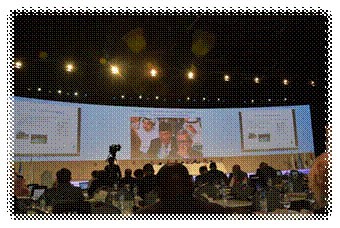
Chair of INTOSAI WGEA presented the WGEA’s achievements from 2014-2016.
In order to disseminate the INTOSAI WGEA products of 2014-2016, the Secretariat of INTOSAI WGEA presented an exhibition booth during INCOSAI XXII in Abu Dhabi. All WGEA products covering research papers, ISSAI reviews, and updated guidance were displayed at the booth.
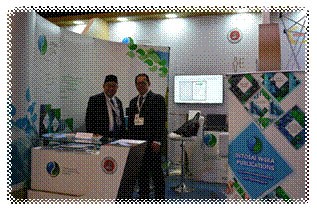
Chair of INTOSAI WGEA and BPK Board Member at the WGEA booth exhibition.
In addition, the Secretariat displayed the WGEA project plan for 2017-2019 to inform the INTOSAI members what WGEA will be doing in the upcoming 3 years and to invite more participants from SAIs to contribute to the WGEA projects.
INTOSAI WGEA will organize the 15th Steering Committee meeting on September 11-15, 2017. Hosted by U.S. GAO, the meeting will be conducted in Washington, D.C. Further information on the meeting will forthcoming from the Secretariat.
 Australia : ANAO Audits Voluntary Carbon Abatement Program
Australia : ANAO Audits Voluntary Carbon Abatement ProgramIn November 2014, the Australian government established the Emissions Reduction Fund—a voluntary effort that allows participants, including farmers and industrial companies, to earn carbon credit units by registering and implementing carbon abatement projects. Through reverse auctions, the government then purchases from willing sellers a proportion of the carbon credit units already earned or expected to be earned in the future by registered projects. The Fund, with Australian government funding of AUD2.55 billion, is one of the primary mechanisms Australia is using to achieve reductions in its greenhouse gas emissions targets. The carbon credit units that are not purchased by the government can be sold on the secondary market to enable other entities to meet their carbon abatement obligations. The Clean Energy Regulator, an Australian government entity, administers the fund.
As of July 1, 2016, 626 projects were registered under the Fund, 236 of which had been credited with a total of 25.4 million carbon credit units; one carbon credit unit equates to one metric ton of carbon dioxide equivalent of abatement. To date, the Clean Energy Regulator has conducted four auctions and contracted to purchase 178 million carbon credit units over the next 10 to 12 years from successful bidders at a cost of AUD2.1 billion. At the four auctions, carbon credit units have been purchased at an average price of AUD11.83 per metric ton.
The objective of an audit by the Australian National Audit Office was to assess the effectiveness of the Clean Energy Regulator’s crediting and selection of carbon abatement for purchase through the Emissions Reduction Fund. The audit concluded that the Clean Energy Regulator had established sound arrangements to manage the crediting and selection of carbon abatement for purchase. However, there were some aspects of the regulatory process that require further attention — such as the level of documentation underpinning some areas of regulatory decision-making—to enable the regulator to better demonstrate the effectiveness of its activities.
Further information about the audit’s findings and conclusions are at https://www.anao.gov.au/work/performanceaudit/emissions-reduction-fund-abatement-crediting-and-purchasing or the Audit Manager, Mr. Grant Caine, can be contacted at grant.caine@anao.gov.au.
 Botswana : OAG Audits Management of Conflict between Humans and Wildlife
Botswana : OAG Audits Management of Conflict between Humans and WildlifeBotswana’s Office of the Auditor General (OAG) is conducting a performance audit of the management of human-wildlife conflict in the country. This conflict occurs when wildlife encroaches on human settlements and imposes costs to both residents and animals. Such conflict is more common inside and around protected areas, where wildlife population density is higher and animals often drift into neighboring cultivated fields or grazing areas.
The audit was motivated by evidence that an increase in livestock in human settlements has caused an increase in human-wildlife conflicts in the past two decades. There is also evidence of a high number of reported incidents of wildlife attacks on livestock, which require financial compensation to farmers. For example, a 2010 audit reported that in 2008 and 2009, the number of livestock killed by different species in the Kgalagadi District was 38, while the number of livestock killed in the Ngamiland District was 730. From 2010 to 2016, the Government paid BWP41,800,547 in compensation to farmers for damages caused by wildlife.
The audit will focus on the adequacy of measures, strategies, and interventions put in place by the Department of Wildlife and National Parks (Ministry of Environment, Natural Resources Conservation and Tourism) to manage human-wildlife conflict.
 Cyprus : Audit of Water Resources Management
Cyprus : Audit of Water Resources ManagementThe Audit Office of the Republic of Cyprus has completed an audit of water resources management. Water scarcity is a major problem in Cyprus, with adverse effects on economic growth, the environment, and agriculture. The objective of the audit was to evaluate the effectiveness and efficiency of (1) the annual national water distribution strategy and (2) policies for water resources management by the public sector, local authorities, and statutory bodies. The audit examined the management of dams, desalination plants, and groundwater bodies; the supply and quality of water for all uses; cost recovery for water services; flood risk management; and the use of alternative water sources, such as tertiary wastewater treatment and rainwater harvesting.
The most important weakness the audit identified was that the information used to prepare the annual water distribution strategy was not complete. Specifically, the audit found that this strategy did not take into account information regarding drought or the cost of operating desalination plants. Other weaknesses identified include the safety of water dams; control of the use of groundwater; and, in certain cases, the quality of groundwater used as drinking water. The audit also found weaknesses with the policies for water resources management, including limited use of tertiary-treated wastewater due to the absence of necessary infrastructure; a delay in applying a pricing policy that could help recover costs for water services; a high rate of non-revenue water in local distribution networks; and an absence of a flood risk management plan.
The full report in Greek and a summary in English are available at www.audit.gov.cy.
For more information, please contact Mr. Akis Kikas, Senior Principal Auditor at akikas@audit.gov.cy.
 Ecuador : Audit of Drinking Water Services in Carchi Province
Ecuador : Audit of Drinking Water Services in Carchi ProvinceThe Office of the Comptroller General of Ecuador conducted a performance audit of the drinking water program in the Province of Carchi. The audit reviewed the availability of authorizations for water use, operation permits, certificates of compliance, and environmental permits from September 1, 2013, to September 30, 2015, and had findings in 80 percent of the documents reviewed. The audit included a comparative analysis using management indicators of municipal service coverage, water quality, loss of drinking water, collection of revenues, and the cost of production recovery. The audit found the absence of effective controls for detecting and reducing water losses that result from leaks, unauthorized connections, breakages, and poor maintenance of the water systems. The water lost during this period was enough to provide water services to about 75,000 residents. That number represents approximately the total population of the cities of Bolívar, Espejo, Montúfar, and Mira, or more than 40 percent of the total population of Carchi.
The audit recommended improvements to the organic structure, planning systems, registration, evaluation, follow-up, and control of the national and local government institutions. In particular, the recommendations addressed how the government institutions regulate their processes and achieve their objectives for water use authorizations, permits, and certificates to guarantee the quality of the water service provision; strengthen the operations of community water systems in rural areas; and conserve publicly owned groundwater sources and recharge zones.
 Estonia : NAO Review of the Impact of State Support for Aquaculture
Estonia : NAO Review of the Impact of State Support for AquacultureThe decrease in natural fish resources is a significant problem around the world, including in the Baltic Sea region. Aquaculture – the farming of fish and other aquatic organisms – makes it possible to increase fish production and consumption while protecting natural resources. The majority of the domestic demand for aquaculture products in Estonia (about 4,500 tons per year) is met through imports. However, domestic aquaculture production has the advantage of providing fresh products as well as jobs to people in rural areas. The European Fisheries Fund provides financial support for fish farmers to encourage domestic aquaculture production.
Estonia’s National Audit Office (NAO) investigated whether this aquaculture support from the European Fisheries Fund from 2007 through 2013 achieved its goal of increasing the volume of domestic aquaculture production without damaging the environment.
The NAO found that the Fund’s financial support has not significantly helped achieve the goal of increasing aquaculture production in Estonia. Although there has been an increase in production capacity, actual production is low and local fish does not reach consumers. The total capacity of Estonian aquaculture production in 2015 was about 4,300 tons, but only 795 tons of fish were sold that year.
The NAO found that a third of aquaculture projects that were designated for support from the Fund were not implemented. The main reasons for this were problems that applicants encountered in guaranteeing selffinancing as well as problems with project selection and assessment. As a result, the Fund did not always choose projects that had the best chance of economic success.
The audit report summary in English is available at: http://www.riigikontroll.ee/tabid/206/Audit/2387/Area/15/language/en-US/Default.aspx
For more information, contact Viire Viss at viire.viss@riigikontroll.ee.
 Kuwait : Audit Office Presents Paper at 17th WGEA Meeting
Kuwait : Audit Office Presents Paper at 17th WGEA MeetingKuwait participated in the 17th meeting of INTOSAI WGEA in October 2016 in Jakarta, Indonesia. Kuwait presented a paper on “How to improve the quality and impact of environment audits.” The paper included four methods to enhance the quality and impact of environmental audit reports:
The paper also discussed challenges and lessons learned.
 Pakistan : Auditor General Selected to Participate in WGEA Projects
Pakistan : Auditor General Selected to Participate in WGEA ProjectsThe Department of the Auditor General of Pakistan (DAGP) actively participated in the 17th INTOSAI WGEA meeting in October 2016. During the meeting, DAGP was selected to lead the 2017-2019 Work Plan project to develop audit guidelines for auditing land organizations and soil quality management to combat desertification. DAGP was also selected as a subcommittee member for two other WGEA projects. The first project will prepare a research paper on environmental health with a focus on air pollution. The second project will develop audit guidelines on delivering the 2030 Agenda for sustainable development goals through environmental auditing.
 Tanzania : NAO Conducts Audit on the Environmental Impact Assessment Process
Tanzania : NAO Conducts Audit on the Environmental Impact Assessment ProcessThe National Audit Office (NAO) of Tanzania delivered to the parliament an audit report on the program for managing the review of environmental impact assessments (EIA) in development projects on March 30, 2016. The audit assessed whether the Vice President’s Office Division of Environment and the National Environment Management Council (the Council) adequately manage the EIA process before implementing development projects.
The audit found the following:
The findings generally revealed that the Council and the Vice President’s Office did not adequately manage the EIA process for development projects. The process does not ensure that projects that are likely to have significant negative effects on the environment are registered and assessed and that all mitigation measures called for in the EISs and EAs are implemented.
The NAO recommended that the Council:
For further information, contact Mr. James Pilly at jpilly@nao.go.tz.
 Thailand : OAG Reviews Efforts to Remove an Invasive Plant from Waterways
Thailand : OAG Reviews Efforts to Remove an Invasive Plant from WaterwaysAn aquatic plant known as water hyacinth has created many problems for water resources in Thailand, including obstructing navigation, shallowing waterways, and blocking river flow. On September 8, 2016, the Ministry of Interior assigned the Department of Public Works and Town & Country Planning to coordinate with organizations responsible for water resources to enhance water flow. These organizations reported removing 6.17 million tons of water hyacinth from October 2015 through July 2016. However, much of the plant remains, especially in the main rivers in the lower part of central Thailand and above the Chao Phraya dam. Furthermore, survey data about the quantity of water hyacinth remaining in these areas are unavailable.
According to operations data collected from the Royal Irrigation Department, the Marine Department, and the Department of Public Works and Town & Country Planning, these organizations spent at least 834.88 million baht to remove 22.37 million tons of water hyacinths in fiscal years 2012 through 2016. However, an audit by the Office of the Auditor General found that the costs to operate these three organizations were very different and their operational controls had weaknesses.
In particular, the audit found limitations in the clarity of the agencies’ operations, databases, and reports. To make the eradication efforts more sustainable, efficient, effective, and worthwhile, the audit proposed that the government:
 United States : GAO Reviews Water Infrastructure Programs for U.S. Cities
United States : GAO Reviews Water Infrastructure Programs for U.S. CitiesThe 2015 discovery of lead in drinking water in the City of Flint, Michigan, highlighted the risks that some cities confront in maintaining drinking water and wastewater infrastructure in the face of declining populations and deteriorating economic conditions. From 1980 to 2010, 99 out of the 674 U.S. cities with populations greater than
50,000 experienced population decline. Many also faced water and wastewater infrastructure problems, including the continued use of lead drinking water pipes. In addition, many older U.S. cities have wastewater systems that are combined with their sewer systems. These systems can discharge sewage to rivers and lakes during rainstorms.
The U.S. Government Accountability Office (GAO) reviewed 10 midsize and large cities with declining populations and the federal programs that could provide those cities with water infrastructure assistance. Representatives from water and wastewater utilities in the 10 cities described major infrastructure needs, including pipeline repair and replacement and wastewater improvements to control combined sewer overflows.
Most of the 14 utilities in the 10 cities GAO reviewed annually increased the cost of water services for consumers to compensate for reduced revenue caused by declining populations and water use, or to pay for rising operating and capital expenses. All of the utilities had developed customer assistance programs, such as payment plans, to help address these higher costs. In addition, most utilities used or planned to use one or more cost-control strategies, such as reducing treatment capacity or decommissioning water or sewer lines in vacant areas. For example, five wastewater utilities may use vacant areas for green infrastructure, such as vegetated areas to enhance on-site infiltration and help control stormwater and sewer overflows.
GAO found that no U.S. programs are specifically designed to provide assistance to cities with declining populations to help pay for water and wastewater infrastructure. However, such cities may receive funding from six programs managed by the Environmental Protection Agency, the Economic Development Administration, the Department of Housing and Urban Development, and the Federal Emergency Management Agency if these cities meet certain eligibility requirements.
The full report is available at http://www.gao.gov/products/GAO-16-785.
For further information, contact Alfredo Gómez, Director, Natural Resources and Environment at gomezj@gao.gov.
 Yemen : A New Approach for Auditing Environmental Policies
Yemen : A New Approach for Auditing Environmental PoliciesYemen’s Central Organization for Control and Auditing (COCA) has exerted enormous effort to develop an approach to auditing environmental policies. The approach includes two objectives:
COCA has observed that international audit guidelines largely focus on how to assess the adequacy of policy implementation but do not give sufficient attention to auditing the content of the policies to determine whether they are in harmony with each other and are suitable for current conditions. In other words, are the policies appropriate for addressing a particular problem?
In developing its approach to auditing, COCA recognizes that the country’s legal structure consists of laws established by the constitution and international treaties, as well as laws established by Parliament and other regulatory bodies. According to COCA, these laws fall into a hierarchy of binding authority, in the following order: constitutional laws, international agreements, laws passed by Parliament and other legislative bodies, and regulations.
Yemen and other countries are party to numerous multinational environmental agreements. When auditing the country’s compliance with international agreements, it is important to determine whether national laws have been enacted to carry out those agreements. The first step in Yemen’s audit approach is to determine whether there are national laws designed to implement the intent of the international agreement. The next step is to determine how well those laws are being implemented.
Auditing Programs to Conserve Genetic Resources
Genetic resources are an important part of biological biodiversity and are an environmental issue with scientific and regulatory aspects at both the local and international level. Most governments, including Yemen, struggle to establish legal controls and rules to comply with international agreements and strategies.
Yemen’s Central Organization for Control and Auditing (COCA) formed an audit team to evaluate genetic resource programs. The team first identified and collected relevant treaties, protocols, and international strategies signed by Yemen. The team then gathered documentation on the relevant laws and regulations administered by government agencies in Yemen. The audit team followed COCA’s general approach for auditing environmental policies.
The audit plan included two parts. The first part was to assess the content of general policies on genetic resources to determine their adequacy. The second part assessed agencies’ program implementation. In particular, the audit included the following objectives:
Using this approach, COCA concluded that a large gap exists between Yemen’s national laws and regulations regarding genetic resources and the policies called for by international agreements and strategies. COCA recommended that Yemen develop a national program to manage genetic resources and traditional knowledge that
involves government agencies and relevant research centers. The program should include a comprehensive plan to document the morphological and genetic data of the nation and identify relevant intellectual property rights and knowledge. The program should also create rules and procedures for providing access to the data for commercial and scientific benefit.
COCA transmitted the results of its audit to ARABOSAI in a report titled, "Audit of Genetic Resources, in Accordance with the Rules of Compliance Audits.”

The INTOSAI Working Group on Environmental Auditing (WGEA) aims to increase the expertise in environmental auditing and to enhance environmental governance with high-quality contribution and visibility by both members of the Working Group and non–member SAIs. Currently the INTOSAI WGEA consists of 86 member countries.
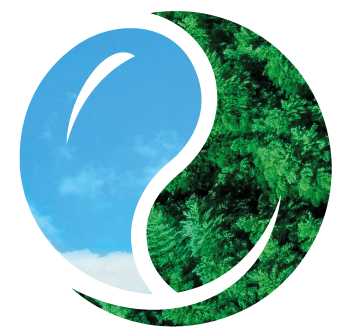
Vivi Niemenmaa - Secretary General
Email: vivi.niemenmaa@vtv.fi
Kati Hirvonen - Project Specialist
Email: kati.hirvonen@vtv.fi
India Roland - International Affairs Planner
Email: india.roland@vtv.fi
Mohamed Ibrahim Jaleel - Environmental Audit Manager
Email: mohamed.jaleel@audit.gov.mv
We collect and process your data on this site to better understand how it is used. We always ask you for consent to do that. You can change your privacy settings here.